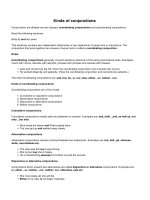Kinds of conjunctions
Bạn đang xem bản rút gọn của tài liệu. Xem và tải ngay bản đầy đủ của tài liệu tại đây (14.8 KB, 2 trang )
Kinds of conjunctions
Conjunctions are divided into two classes:
coordinating conjunctions
and subordinating conjunctions.
Read the following sentence:
Birds fly
and
fish swim.
This sentence contains two independent statements or two statements of equal rank or importance. The
conjunction that joins together two clauses of equal rank is called a
coordinating conjunction.
Notes
Coordinating conjunctions
generally connect sentence elements of the same grammatical class. Examples:
nouns with nouns, adverbs with adverbs, phrases with phrases and clauses with clauses.
Jack and Jill went up the hill. (Here the coordinating conjunction and connects two nouns.)
He worked diligently and patiently. (Here the coordinating conjunction and connects two adverbs.)
The chief coordinating conjunctions are:
and, but, for, or, nor, also, either…or, neither…nor.
Kinds of coordinating conjunctions
Coordinating conjunctions are of four kinds.
1. Cumulative or copulative conjunctions
2. Adversative conjunctions
3. Disjunctive or alternative conjunctions
4. Illative conjunctions
Cumulative conjunctions
Cumulative conjunctions merely add one statement to another. Examples are:
and, both…and, as well as, not
only…but also.
Alice wrote the letters
and
Peter posted them.
The cow got up
and
walked away slowly.
Adversative conjunctions
Adversative conjunctions express contrast between two statements. Examples are:
but, still, yet, whereas,
while, nevertheless etc.
The rope was thin
but
it was strong.
She is poor
but
she is happy.
He is hardworking
whereas
his brother is quite the reverse.
Disjunctive or alternative conjunctions
Conjunctions which present two alternatives are called
disjunctive or alternative
conjunctions. Examples are:
or, either…or, neither…nor, neither, nor, otherwise, else etc.
She must weep,
or
she will die.
Either
he is mad,
or
he feigns madness.
They toil not,
neither
do they spin.
Neither
a borrower,
nor
a lender be.
Illative conjunctions
Some coordinating conjunctions express something inferred from another statement or fact. These are called
illative conjunctions
. Examples are:
for and so
.
Somebody came,
for
I heard a knock at the door.
He must be asleep,
for
there is no light in his room.
He has been working hard,
so
he will pass.
Be first to know when grammar rules change! Sign up to our newsletter here: englishgrammar.org (It's free)
Powered by TCPDF (www.tcpdf.org)









